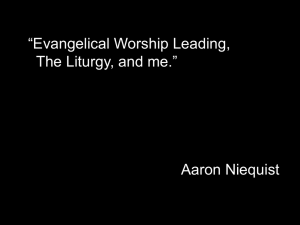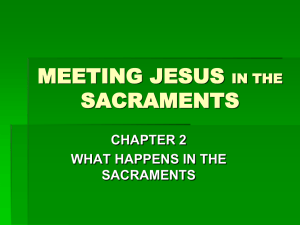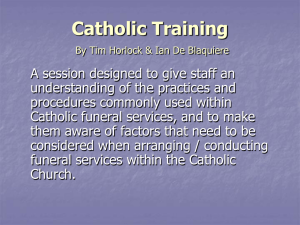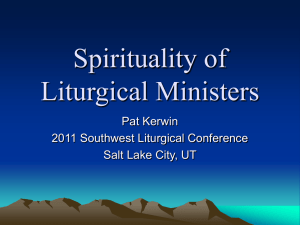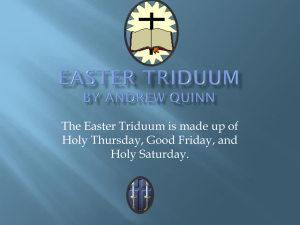1_The Liturgy
advertisement
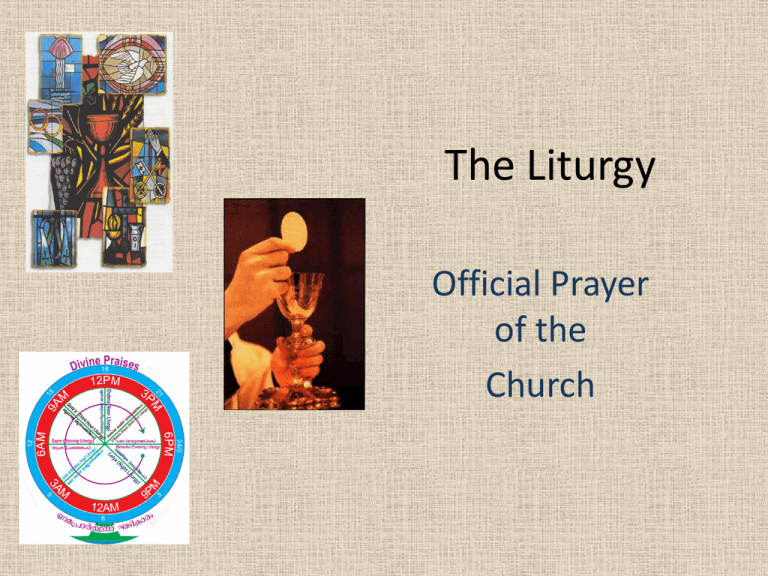
The Liturgy Official Prayer of the Church Answer these ?s in you notebook. • What is the Paschal Mystery? • What is the Church? • Why do we study the Liturgy after our study of the Paschal Mystery and the Church? • Why does our study of the sacraments begin with a study of the Liturgy? Answers. • What is the Paschal Mystery? – The work of salvation accomplished by Jesus mainly through his life, Passion, death, Resurrection and Ascension • What is the Church? – The whole membership of the baptized who work in union with each other to participate in God’s work. • Why do we study the Liturgy after our study of the Paschal Mystery and the Church? – Our understanding of the paschal mystery and the Church is necessary to our understanding of the importance of the liturgy • Why does our study of the sacraments begin with a study of the Liturgy? – The sacraments are one part of the liturgy. We must understand the whole idea of the liturgy to then understand any liturgy that is part of the whole Vocabulary (copy now) • • • • • • • • • • Advent Christmas Eastern Catholic churches Epiphany Icon Lent Liminal Liturgical Year Liturgy Magisterium • • • • • • • • • Ordinary time Paschal mystery Passover Pentecost Ritual Tradition Triduum Trinity World Youth Day Introduction to the Liturgy • What is Liturgy? • What is the connection between the Holy Trinity & Liturgy? • What is the Liturgical calendar? • What is the importance of Liturgical rites and Traditions? • How do we celebrate the Liturgy? The Liturgy • What is the Liturgy? – The official, public, communal prayer of the Church – God’s work of salvation in which we are called to participate – Ritual, repeated, meaningful symbols and actions – Decreed by Jesus “Do this in Memory of Me” What is the Liturgy? • The Church’s official, public, communal prayer. It is God’s work in which the People of God, the Church, participate. The most important Liturgy is the Eucharist or the Sacrifice of the Mass. – Eucharist carries out Jesus command to “Do this in Memory of Me” – Comes from the Latin, leitourgia, meaning the peoples’ work – The Liturgy is the general term for all liturgies. We can participate in a Liturgy • • • • Mass Sacraments Liturgy of the Hours Catholic funerals Liturgical Books • Roman Missal – Used by the priest at Mass, contains all the prayers of the Mass • Lectionary for Mass – Contains the readings for Mass, first, second, responsorial psalm and gospel acclamations • Book of Gospels – Contains only the Gospels • Rite of Baptism for children – Contains the rituals necessary for baptism. Each sacrament and other blessings and consecrations has a separate book • Liturgy of the Hours – Readings, hymns and prayers for the seven “hours” of the day. There is a book for each “season” of the year Work of God • As a community we are the “Body of Christ”. • We are adopted children of God through Jesus and the Holy Spirit • We were wounded by Original Sin therefore needed God’s help to restore the original state of perfect communion with Him. • God promises salvation to the first humans and then begins his work with Abraham, Moses, the judges, David, and the prophets. • Through Jesus, God intervenes and restores our relationship through the Paschal Mystery. Our redemption is accomplished. • Through Jesus we receive a new law that fulfills the old law. • Through the Holy Spirit we share the grace of God that helps us to live the new law. • When we gather for liturgy we celebrate the Paschal mystery and receive the grace of the Spirit • We are called to gather together and participate in liturgy that in turn encourages us to go out and bring the good news to others Creation Salvation History Redemption • Created in Original Justice • Original Sin breaks our relationship • God promises to help restore our relationship • God begins to work for our salvation by setting his plan in motion with Abraham • His plan continues through Moses and the Law, David and prophets • Through His life, passion, death, resurrection and ascension (Paschal mystery) Jesus restores our relationship with God • The Church with the help of the Holy Spirit continues the work of salvation. • The Liturgy is the way we participate in God’s work of salvation Liturgy Liturgy, Scripture & Tradition • Where does our Liturgy come from? – Christ is its origin – Scripture and Tradition give us the essential elements of Liturgy • Transmit the Word of God • Form a single deposit of faith – The beliefs handed down from the time of the Apostles that makes clear the truths that cannot be laid aside since they are part of God’s revelation. – The Magisterium, with the guidance of the Holy Spirit, is responsible for interpreting the deposit of faith – The traditions that have influenced the Liturgy are customs, things we do because they are part of our history and culture • Washing hands – Essential elements are kept where traditional elements may be kept, modified or eliminated with the guidance of the Magisterium Origin in Christ • Tradition comes from the word traditio that means to “hand on or give over”. • Our liturgy has been handed on to us by Jesus – “took bread, said the blessing, broke it and giving it to the Apostles said “take and eat, this is my body” – “I received from the Lord what I also handed on to you, that the Lord Jesus, on the night he was arrested, took bread…. – Our liturgy has been handed on as the richest inheritance of the Church The Holy Trinity & The Liturgy • Liturgy is Trinitarian – The Trinity is at work in the Church’s Liturgy- Father, Son, & Holy Spirit – Trinity is the central mystery of the Christian faith • Begins with “In the name of the Father…” • Ends with a blessing of the Holy Trinity • Each person is involved in the Church’s Liturgy – Father is the source of all blessings of creation and salvation – Jesus who became incarnate to redeem us is central in the Liturgy – Christ’s gift of himself is made present to us by the power of the Holy Spirit The Rublev Icon Andrei Rublev, 1425 Trinitarian Liturgy • In every liturgy, especially the Seven Sacraments, the Church encounters God, Father, Son, and Holy Spirit – Sacrament is something that makes Christ present to us • Liturgy is sacramental • Church is sacramental – Through sacraments we receive God’s grace, a sharing in his life and love; we are drawn into communion with the Trinity • We are justified, made righteous and holy • We are prepared for life in perfect communion with God in heaven – Liturgy is the prayer of the Church, in heaven, on Earth and in Purgatory • We are connected to all of those outside of time and space, Mary, angels, saints, etc. “Through Christ Our Lord” • We are united with the Trinity because God the Father saves us through the actions of God, the Son, and we are able to live as Christ with the help of God, the Holy Spirit. • Christ is present in all liturgy – In the ordained minister who acts in the person of Jesus. – In the assembly of people, as the “Body of Christ” – In the Scripture, the “Word of God” that is an essential element of every liturgy – In the Eucharist, in a special way, Jesus is truly present in Body and Blood “In the Unity of the Holy Spirit” • Prepares us to encounter Jesus • Helps the assembly to see Jesus Presence within itself, in the Scripture and in the sacramental actions • During the epiclesis, he transforms the bread and wine into the Body and Blood, the real presence, of Jesus, making Christ’s saving work present and active, here and now. • The Holy Spirit helps us to take the message of God’s love to all whom we meet. Trinitarian Doxology Through Him, with Him, in Him, In the unity of the Holy Spirit all glory and honor is yours almighty Father forever and ever. Amen. Liturgical Calendar •Celebrates God’s Time •Celebrates the whole of the Paschal Mystery, from the Incarnation to Pentecost •Anticipates the end of time Purple White/Gold Green Waiting, penance Joy Hope • Advent: – Begins the Liturgical year – a time of preparation, 4 weeks before Christmas • To celebrate the birth of God made flesh • To celebrate Jesus coming into our own hearts • To prepare for the final coming of Jesus • Christmas: – Begins on Dec. 25th ends with the Solemnity of the Baptism of Jesus (3rd Sunday after Christmas) • Includes Epiphany on the 12th day of Christmas (revelation to the Gentiles) • Ordinary Time: – Numbered with ordinal numbers. – Two sections in the year, • 1st from Christmas to Lent, • 2nd from Pentecost to Advent. • Lent: – Begins on Ash Wednesday – Encouraged to fast, pray and give alms – Focus on what Jesus did for us • Easter Triduum – Three Days when we remember in the most intense way the suffering and death of Jesus • Begins the evening of Thursday and ends Sunday evening (in the Jewish tradition) – Holy Thursday: Mass of the Lord’s Supper – Good Friday: Reflect on Passion narrative, venerate the Cross – Easter Sunday: Easter Vigil on Saturday evening- great celebration with candles, fire, water and the welcoming of new members • Easter Season: – Begins on Easter Sunday and continues to Pentecost Sunday, 50 days later. • • • • Coincides with spring (goddess Estre, goddess of Spring) Liturgy speaks of new life Centers on the hope of our new life, an everlasting life. Ends with Pentecost, the Church is revealed and we like the apostles are sent forth to carry out Jesus’ mission to the world Liturgical Rites & Traditions Roman Catholic Church (1) • Latin Rites – – – – – – – Roman Rite*** Ambrosian Rite Mozarabic Rite Bragan Rite Dominican Rite Carmelite Rite Carthusian Rite Eastern Catholic Churches (21) • Eastern Rite – – – – Antiochene Rite Chaldean Rite Byzantine Rite Alexandrian( Coptic, Ethiopian) Rite – Armenian Rite • Follows its own ancient traditions, has its own Bishops and different liturgical language and liturgical customs United under the leadership of the Bishop of Rome, the Pope They either chose to remain united with the Roman church at the time of the Schism (1054AD) or reunited with it later. Celebrating the Liturgy • All Liturgical celebrations are the same because Jesus is present in the same way whether a large or small group, a renown celebrant or a local priest, music or silent. • Tips for celebrating the Liturgy – – – – – – – – – – Be there, physically, mentally and spiritually Ask the Holy Spirit for help to fully participate Listen and participate in the prayers Listen to the readings and let them affect you Fervently pray during the Prayer of the Faithful If there is singing, join in, singing hymns is like praying twice according to St. Augustine Respond during the liturgy with your heart as well as your mouth Use your whole body in prayer Receive Communion with reverence, you are holding the real body of Christ When you leave Mass, obey the command to “Go forth” and bring the good news out to the world with you. Structure of Liturgy • Introductory Rites – Greeting – Opening prayer • Liturgy of the Word – Readings • Celebration of Sacrament – Essential elements • Liturgy of the Eucharist – Consecration and reception of Eucharist • Concluding Rites – Blessing – Dismissal • Read – 2 Samuel 7:1-5, 8-11, 16 – Luke 1: 26-38 • Do 1. Follow these steps a. Identify a challenge that is presented in each reading. b. Describe the response to the challenge. c. What is the result of the response? 2. Identify how the challenges are similar in the two readings 3. How does this challenge relate to challenges in your own life? 4. How does participating in the Liturgy help you to connect your life to the Paschal Mystery? Tanner, Henry Ossawa, “The Annunciation”, 1898 Michelangelo's Pieta Michelangelo's Pieta Tanner, Henry Ossawa, “The Annunciation”, 1898 Yet you do not blink. In the intimacy of a bedchamber Your soul is awakened from sleep, Fragile flesh before angelic brilliance. Your rumpled night sheets tossed aside, You listen in peace with your whole self To the question that will define history. Holding its breath for your answer, All heaven pauses. LET IT BE DONE TO ME Here it begins. In such utter simplicity, In quiet strength, at the appointed hour, With the rippled rungs of time at your feet, And the broad lines of history at your back. At the balance of His grace in your will, Eve reborn, humanity to be redeemed Through a child, from a virgin Whose name is Mary. J. Michael Sparough Tanner, Henry Ossawa, “The Annunciation, 1898
